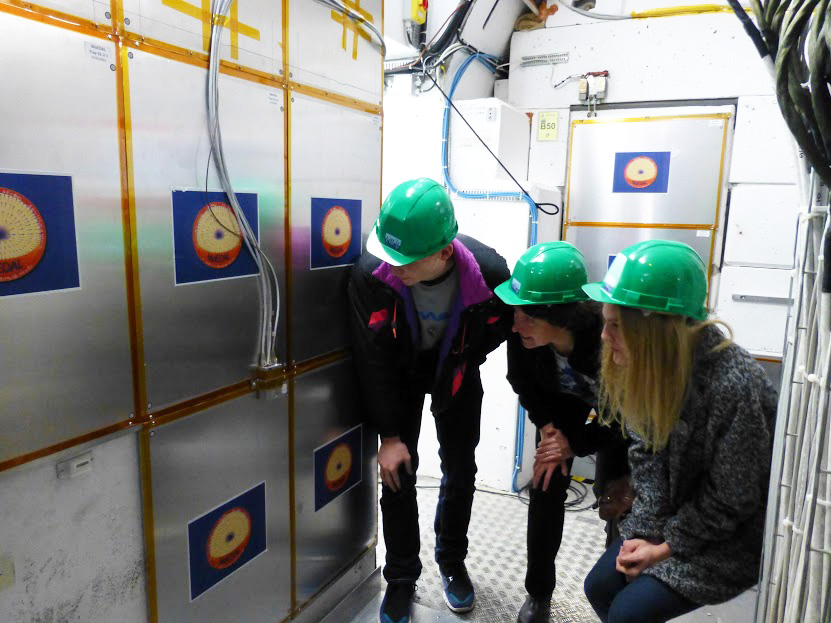MoEDAL - the LHC’s Magnificent 7th Experiment
MoEDAL, the 7th and newest experiment is dedicated to the detection of the highly ionizing particle avatars of new physics such as the magnetic monopole and massive stable or metastable charged particles. Such particles originate from a number of beyond the Standard Model scenarios that, for example, incorporate: magnetic charge, new symmetries of nature (eg Supersymmetry); extra spatial dimensions; dark matter particles, etc. The MoEDAL detector is a largely passive detector that makes it totally unlike other collider detectors. It is due to start data taking in the Spring of 2015.
The MoEDAL detector shares the IP8 intersection region with the LHCb’s VELO detector as shown in Figure 1. It is comprised of the largest array (~280 sqm) of plastic Nuclear Track Detector (NTD) stacks ever deployed at an accelerator that surrounds the intersection region at Point 8 on the LHC ring. Another unique feature of the detector is the use of paramagnetic trapping volumes to capture both electrically and magnetically charged highly ionizing particles. In this way we can directly measure magnetic charge and actually ensnare new particles for further study. No other LHC detector has this capability. It does have one active real-time electronics detector system based on an array of the state-of-the art TimePix pixel devices for monitoring the radiation background in the MoEDAL/VELO cavern.

Figure 1 A visualization of the MoEDAL detector deployed at LHC IP8
MoEDAL does not suffer from the problems that would severely hamper detection of slow moving and/or highly ionizing particles at the main LHC detectors. Its largely passive detection systems require no trigger, electronics, high voltage or gas supply. Additionally, the low mass (~1cm thick) and uniformity of the detection technology require minimal support systems and maximum cost effective coverage. Hence the elements of MoEDAL can be deployed relatively close to the intersection point with the minimum number of experimental compromises. The calibration of the response of MoEDAL to highly ionizing particles at a heavy-ion beam is straightforward, but not possible for the ATLAS & CMS experiments.
The detection of, say a candidate Magnetic Monopole event in MoEDAL would result in a string of up to 20 etch pits per stack with charge resolution of ~0.05e, and spatial resolution of ~10 mms per etch pit, with no Standard Model background. Such an event would be permanently recorded. Additionally, the detection of the magnetic field of a trapped magnetic monopole would also provide permanent record of the discovery that would be validated by corresponding evidence in the NTD detectors. In standard collider detectors, a largish (10-100) sample of candidate events is typically needed to establish a discovery signal, even with small estimated backgrounds. Due to the absence of Standard Model backgrounds, only one detected track – and/or one trapped magnetic monopole - would provide a clear discovery.
Since the MoEDAL experiment was approved by the CERN Research Board in 2010 the collaboration has doubled in size to include approximately 44 physicists from eighteen groups from around the world: Canada, CERN, the Czech Republic, Finland, Germany, Italy, Korea, Romania, Switzerland, the UK and the USA. The latest group to join MoEDAL is the Star Institute of the Simon Langton School in the UK. Their main responsibility would be to monitor the radiation background data from the TimePix array using the experience they gained deploying TimePix detectors in Space! A high school joining an international physics collaboration is surely a world first. A photograph showing the Langton School MoEDAL group inspecting a MoEDAL TimePix pixel device installation is shown in Figure 2.

Figure 2 The leader of the Star Institute's MoEDAL group (Becky Parker) and two of her school students inspecting a MoEDAL test TimePix detector deployment adjacent to a number of MoEDAL ~TDR” NTD detector stacks
Over the past year MoEDAL experimenters have completed the design of two new detectors systems: the Magnetic Monopole Trapping (MMT) detectors for capturing magnetic monopole and other massive highly ionizing particles; the high threshold Very High Charge Catcher – comprised of flexible low mass NTD detectors. These add to the existing low threshold “TDR” NTD system. A test “TDR” system, deployed in the spring of 2010 was removed at the beginning of the long LHC shutdown in the Winter of 2012, has been calibrated and etched and is now being analyzed. In addition, a prototype MMT system, exposed during 2011, was extracted and monitored for the presence of trapped magnetic charge at ETH Zurich’s SQUID magnetometer facility. Results from these tests were reported in Italy in March at the 48th Rencontres de Moriond held at La Thuile, and in September at the ICATPP conference held at Lake Como.
The coming year will be a busy one for the MoEDAL collaboration. A second Physics Workshop is being planned for the Spring of 2014. By that time an up to date and comprehensive paper on MoEDAL’s Physics Program will have been published. In addition, the collaboration will publish results from test detectors deployed during p-p and p-Pb running. Last, but certainly not least, MoEDAL physicists will be engaged on constructing the various MOEDAL detector system and planning for the installation of the full detector at Point 8 on the LHC ring in the Winter of 2013/14. The MoEDAL experiment will start to take data in the Spring of 2015 when the LHC restarts at the unprecedented centre-of-mass energy of near 14 TeV.
